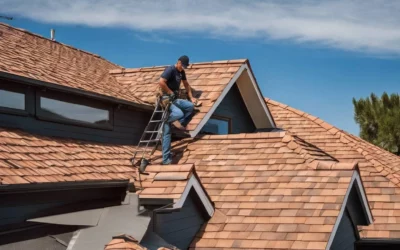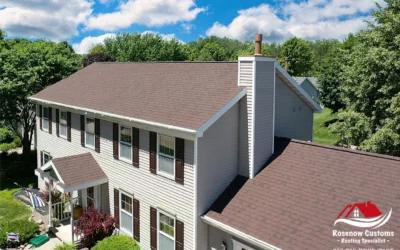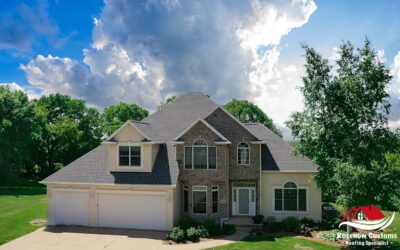Understanding Shingle Roof Replacement Materials
Embarking on a shingle roof replacement journey requires a solid understanding of the various materials at your disposal, a process that Rosenow Customs, a skilled Roof Replacement Contractor, can expertly guide you through. The spectrum of choices ranges from the commonly used asphalt shingles to the technologically advanced solar shingles. Each material brings its unique set of attributes to the table, catering to different needs and preferences. This segment aims to provide a comprehensive overview of these materials, shedding light on their specific applications, advantages, and factors to consider.
Asphalt Shingles
Asphalt shingles hold the title for being the most popular roofing choice across North American households. Their appeal lies in their cost-effectiveness, ease of installation, and relatively straightforward maintenance, setting them apart in the roofing material landscape.
The composition of asphalt shingles involves a fiberglass base drenched in asphalt and topped off with a coating of mineral granules. This structure equips them with the resilience to offer robust protection against the elements. They are available in a plethora of colors and styles, even mimicking the aesthetic of pricier materials like stone or wood.
The lifespan of asphalt shingles is another selling point. While it can fluctuate based on weather conditions and the quality of the shingles, asphalt roofing typically endures between 15 and 30 years.
However, it’s important to note that while asphalt shingles offer a reasonable lifespan, they may not match up to the durability or environmental friendliness of some other roofing materials. Extreme weather conditions can cause them to crack, and temperature fluctuations can impact their integrity.
Maintenance-wise, asphalt shingles necessitate periodic inspections, especially after harsh weather, to ensure they remain intact and undamaged. The repair process is relatively simple and cost-effective, as damaged shingles can be individually replaced without the need for a complete roof overhaul.
While installing asphalt shingles might seem like a feasible DIY project, it’s advisable to opt for professional installation. Incorrect installation can lead to issues like leaks or premature wear and tear, potentially invalidating the warranty.
Metal Roof Shingles
In the realm of roofing materials, metal shingles have carved out a niche for themselves. Their rise in popularity can be attributed to their robustness, energy-saving properties, and the wide range of aesthetic options they offer.
These shingles are crafted from a variety of metals, including steel, aluminum, copper, and zinc alloy. Their sturdy construction ensures your home remains protected against severe weather conditions, be it high winds, torrential rain, snow, or even fire. With a lifespan ranging from 40 to 70 years, metal shingles are a cost-effective solution for long-term roofing needs.
One standout feature of metal roofs is their ability to reflect solar heat, unlike their asphalt counterparts that tend to absorb it. This characteristic significantly reduces cooling expenses during the hotter months, making metal shingles an ideal choice for homes in warmer regions.
While the initial investment in a metal roof may be higher than asphalt shingles, the long-term benefits outweigh the upfront cost. The durability of metal roofs means they are less likely to crack, warp or corrode, leading to lower repair and maintenance costs.
Contrary to popular belief, metal roofs are not limited to contemporary design aesthetics. With a range of finishes and profiles, metal shingles can mimic the appearance of other materials like clay, slate, or wood, catering to diverse architectural styles.
Despite the relative ease of installing metal roofs, it’s advisable to engage professional services. This ensures a secure installation, preventing potential issues like leaks or damage that could compromise the material’s longevity and durability.
Wood Shingles
For homeowners seeking a classic and timeless look, wood shingles are an excellent choice. Available in a variety of woods such as cedar, pine, redwood, and cypress, these shingles offer more than just natural beauty.
With a lifespan of 30 to 50 years, wood shingles are a durable roofing option. They also excel in insulation, providing double the insulation capacity of asphalt shingles.
The charm of wood shingles lies in their rustic aesthetic. They seamlessly blend with natural surroundings and can enhance traditional architectural styles. Their versatility extends to their color options as well, as they can be painted or stained to match your home’s exterior.
Wood shingles are also an eco-friendly choice. Being a natural material, they are biodegradable, and any replaced shingles can be recycled or composted.
However, wood shingles do come with their own set of challenges. They are more expensive than asphalt but cheaper than tile or slate. They are also prone to fire, insects, and mold, necessitating regular maintenance to maximize their lifespan. To mitigate fire risks, consider opting for wood shingles treated with fire-resistant chemicals.
Despite these potential drawbacks, with proper installation and diligent maintenance, wood shingles can offer a unique blend of aesthetic appeal and structural strength to your home’s roof.
Solar Shingles
In the realm of roofing materials, solar shingles, also known as photovoltaic shingles, represent a modern fusion of conventional roofing and solar technology. These shingles not only protect your home from the elements but also harness the power of the sun to generate electricity.
The allure of solar shingles lies in their potential to significantly cut down on electricity bills. By absorbing sunlight and converting it into usable power, these shingles can even generate surplus energy that can be sold back to the grid, creating a potential revenue stream for homeowners.
From an aesthetic standpoint, solar shingles offer a sleek alternative to traditional solar panels, which can be bulky and visually intrusive. Designed to mimic the appearance of standard roofing materials like asphalt or slate, solar shingles blend seamlessly with your roof, offering a stylish solution for those keen on maintaining a traditional look while embracing renewable energy.
Durability is another selling point of solar shingles. Many manufacturers offer warranties spanning 20 to 25 years, although it’s not uncommon for these shingles to outlast their warranty period.
However, homeowners should be aware of a few factors. The upfront costs of solar shingles, including installation and associated equipment, can be significantly higher than that of traditional roofing materials. But these costs can be recouped over time through energy savings. Furthermore, the efficiency of solar shingles is dependent on the amount of sunlight received and can be affected by the roof’s pitch, orientation, and any shading from nearby trees or buildings.
In summary, while solar shingles may require a substantial initial investment, they can lead to considerable long-term savings. Moreover, their integration of renewable energy technology can boost property value and contribute to environmental sustainability.
Tile and Slate Shingles
When it comes to high-quality roofing materials, tile and slate shingles stand out for their superior durability, unique aesthetics, and exceptional lifespan.
Tile shingles, typically crafted from clay or concrete, are lauded for their resilience and versatility. They can endure harsh weather conditions and are highly resistant to damage from fires, hurricanes, earthquakes, and even mold. With proper maintenance, tile roofs can serve your home for up to a century, making them a sound long-term investment. In terms of aesthetics, tile shingles offer a distinctive Spanish or Mediterranean flair that can enhance your home’s exterior appeal.
Slate shingles, hewn from natural stone, are a premium roofing option that offers unrivaled durability. With regular upkeep, slate roofs can last for over a hundred years. This material lends a refined look that can significantly boost your home’s value.
However, due to their weight and fragility, both tile and slate shingles require professional installation to maintain their integrity. It’s also crucial to ensure that your home’s structure can support the additional weight of these materials.
While tile and slate shingles carry a higher price tag than other roofing materials, this reflects their quality, durability, and aesthetic appeal. Despite the initial cost, their longevity and minimal maintenance needs make them a cost-effective choice over the long run.
In essence, tile and slate shingles are an excellent choice for homeowners seeking a high-end, durable, and visually striking roofing solution. While the upfront cost may be higher, the long-term benefits of durability, lifespan, and minimal maintenance make them a worthwhile investment.
Choosing the Right Material for Shingle Roof Replacement
Selecting the ideal material for your shingle roof replacement is a multifaceted decision. It’s not solely about finding a material that aligns with your aesthetic taste. Practical considerations, including your local climate, architectural style of your home, budget, the projected duration of your stay in the house, and your environmental concerns, also play a significant role.
The chosen roofing material should not only enhance your home’s architectural beauty but also withstand your local weather conditions. Certain materials fare better in hot, arid climates, while others are designed to endure areas with heavy precipitation.
Budget-wise, the initial costs are undoubtedly important, but the longevity of the material and upkeep costs should also be part of your financial considerations.
Moreover, the environmental footprint of your roof material can’t be overlooked. For homeowners with a green thumb, factors like sustainability, recyclability, and energy efficiency of a roof material may be crucial.
In the subsequent sections, we will explore these considerations in more detail to guide you in making an informed decision for your shingle roof replacement. This will ensure that your choice not only enhances your home’s visual appeal but also delivers efficient performance for many years.
Climate and Home Style Considerations
Understanding your region’s typical weather conditions is vital in determining the most suitable roofing material for your home. Various materials are engineered to resist different weather conditions.
For instance, in regions with high temperatures and intense sunlight, light-colored or reflective shingles such as metal or solar shingles could be a wise choice. These materials can reflect the sun’s rays, thereby reducing cooling expenses. If your home is situated in areas with high humidity or frequent heavy rainfall, moisture-resistant materials like asphalt or tile shingles might be more fitting. For climates prone to strong winds or hail, impact-resistant materials like metal or slate are recommended.
The architectural style of your home also plays a significant role. The roof should enhance your home’s architectural design and increase its curb appeal. Traditional homes may find the rustic allure of wood shingles appealing, while tile roofs often complement Spanish or Mediterranean-style homes. Modern homes might opt for metal or solar shingles for a sleek, contemporary look, while slate often adds a touch of classic elegance to historic or upscale homes.
However, it’s important to remember that while climate and home style are key factors, they should be evaluated in conjunction with other considerations like cost, lifespan, and environmental impact. Balancing all these elements will help you select a roofing material that not only beautifies your home but also offers durability and value for your investment.
Budget and Lifespan Considerations
When it comes to choosing a roofing material, your budget plays a pivotal role. However, it’s important to note that the overall cost isn’t just about the initial purchase of materials. Installation expenses and future repair costs should also be factored into your budget. For example, asphalt shingles may seem like a cost-effective choice initially, but their shorter lifespan could necessitate more frequent replacements, thereby increasing long-term costs.
Conversely, roofing materials such as tile, slate, or solar shingles might require a larger initial investment, but their superior durability and extended lifespan can make them a more economical choice in the long run. Solar shingles offer an additional benefit of potentially reducing your energy bills, adding to their cost-effectiveness.
The lifespan and durability of the material are equally crucial considerations. Different materials have varying resistance to weather conditions and age differently. For instance, while wood shingles offer aesthetic appeal, they may not endure as long as metal or tile, particularly in humid climates. Metal and tile shingles, on the other hand, are resilient choices that can withstand severe weather conditions and may require fewer repairs.
Solar shingles, while robust, will need regular professional inspections to ensure the integrated solar cells are functioning efficiently. Therefore, when determining your budget, it’s essential to strike a balance between upfront costs and the long-term value provided by the material’s lifespan and durability. The optimal choice will offer a blend of affordability, durability, maintenance costs, and visual appeal that matches the homeowner’s requirements and future plans for the property.
Environmental Impact
In today’s world, where environmental sustainability is a growing concern, the selection of roofing material can significantly contribute to reducing a homeowner’s ecological footprint.
For those homeowners who prioritize sustainability, choosing renewable, recyclable, or sustainable materials can make a significant difference. For instance, metal roofing often contains a high percentage of recycled materials and can be fully recycled at the end of its lifespan. Additionally, its reflective properties can decrease energy consumption by reducing cooling requirements in hot climates.
Solar shingles are another eco-friendly option. These shingles convert sunlight into electricity, potentially fulfilling a significant portion of a home’s energy requirements, thereby reducing dependence on traditional energy sources and decreasing carbon emissions.
Wood shingles, often crafted from reclaimed or recycled wood, can also be an environmentally friendly choice. However, their combustibility may make them unsuitable for areas prone to wildfires.
Conversely, while asphalt shingles are an affordable and popular choice, they have a higher environmental impact due to their shorter lifespan and limited recyclability. Therefore, when selecting your roofing material, it’s essential to balance your preferences for aesthetics and durability with the material’s potential environmental impact. Your decision can have a profound effect, not only on your home but also on the broader environment.




